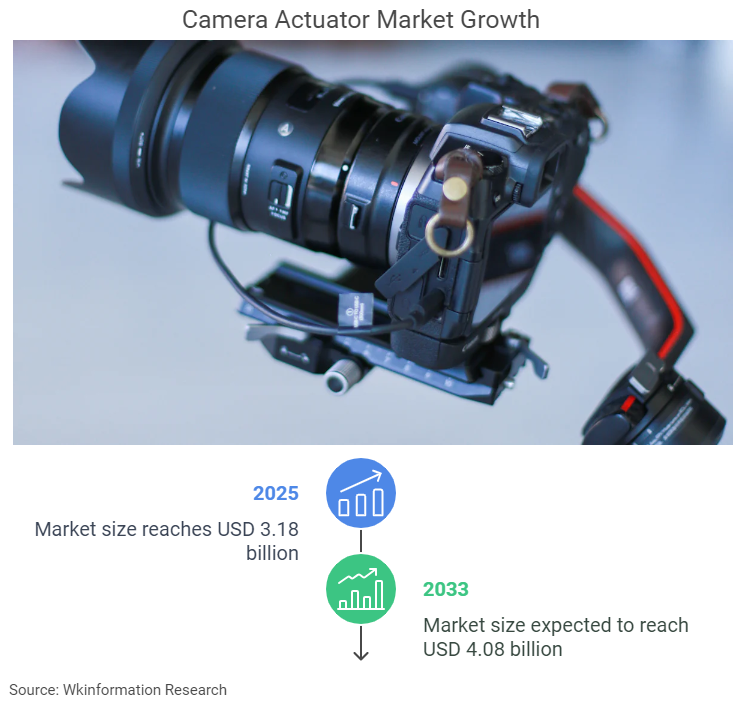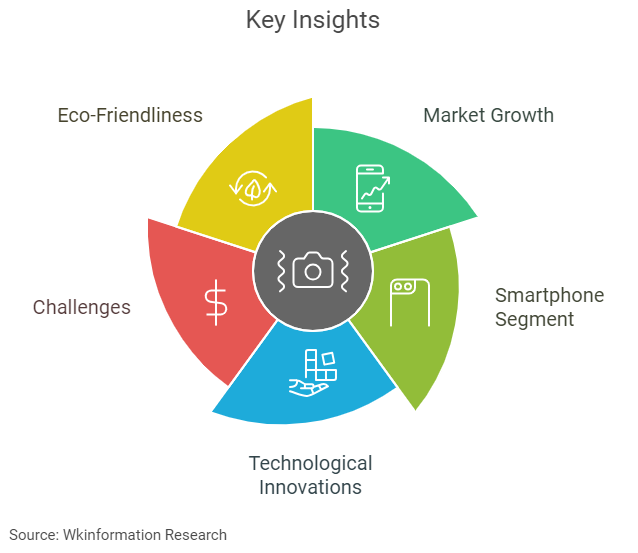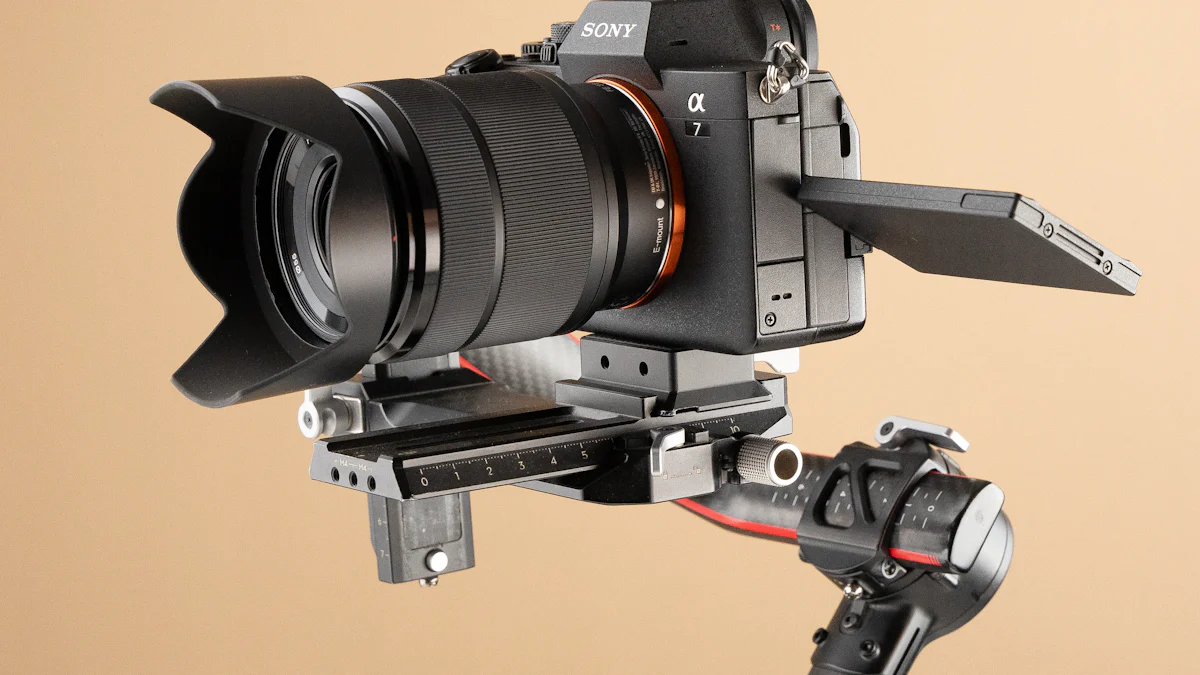
The camera actuator market is poised for steady growth between 2025 and 2033, driven by advancements in imaging technology and increasing consumer demand for high-quality visuals.The market size will reach USD 3.18 billion in 2025 and is expected to reach USD 4.08 billion by 2033, with a CAGR of 3.16% from 2025 to 2033.
Key factors fueling this expansion include the rising popularity of multi-camera setups in smartphones and the proliferation of social media platforms emphasizing visual content. Additionally, innovations in AI-powered autofocus systems and their integration into AR/VR devices present significant opportunities for market players. However, challenges such as high production costs and rapid technological changes remain critical considerations for industry stakeholders.
Key Insights
- The camera actuator market is growing and may reach $4.08 billion by 2033. This growth is due to better imaging tech and demand for clear visuals.
- Smartphone camera actuators are growing fast, with an 3.16% yearly increase expected until 2033. This is because of more cameras in phones and social media’s focus on pictures.
- New tech like AI-powered actuators and smaller designs improve performance. These also create chances in areas like cars and AR/VR.
- Problems like high costs and competition from other imaging tech need solutions for steady growth in this market.
- Eco-friendliness is now important. Companies are using green materials and methods to meet rules and customer needs.

Growth Drivers and Challenges in the Camera Actuator Market

Key Growth Drivers
Rising demand for high-resolution smartphone cameras
The increasing consumer demand for high-quality smartphone cameras continues to drive the camera actuator market. The proliferation of social media platforms has amplified the need for superior image quality, as users prioritize visually appealing content. Additionally, the trend toward multi-camera setups in smartphones has further fueled the growth of the smartphone camera actuator market. These setups enhance image quality by offering features like optical zoom and depth sensing, which rely heavily on advanced actuators.
Expansion of the automotive and surveillance industries
The automotive and surveillance sectors represent significant market drivers. In the automotive industry, the integration of camera systems in advanced driver-assistance systems (ADAS) and autonomous vehicles has increased the demand for reliable actuators. Similarly, the growing need for high-resolution imaging in security and surveillance systems has created opportunities for the camera actuator market. These applications require precise and durable actuators to ensure optimal performance in various environments.
Technological advancements in actuator design
Technological advancements in actuator design have played a pivotal role in market growth. Innovations such as miniaturization and the integration of smart features like sensors and IoT connectivity have enhanced actuator efficiency and performance. These developments not only improve existing applications but also open new opportunities in sectors like medical devices and autonomous vehicles. As a result, the demand forecast for camera actuators remains positive across multiple industries.
Challenges Impacting Growth
High production costs and supply chain disruptions
The camera actuator market faces challenges related to high production costs and supply chain disruptions. Intense price pressure in the smartphone industry often leads to compromises in actuator quality. Additionally, the technical challenges of miniaturization increase research and development costs, slowing the introduction of new technologies.
Competition from alternative imaging technologies
Alternative imaging technologies, such as optical image stabilization (OIS) and electronic image stabilization (EIS), present significant competition. These technologies offer enhanced image quality without relying heavily on traditional actuators. The adoption of OIS in mid and low-end smartphones is expected to grow, further impacting the smartphone camera actuator market.
Environmental and regulatory constraints
Environmental and regulatory constraints also pose challenges for the industry. The production of actuators involves materials and processes that must comply with stringent environmental regulations. These constraints can increase production costs and limit the scalability of manufacturing operations.
Market Segmentation of the Camera Actuator Market
By Type
Voice Coil Motors (VCM)
Voice Coil Motors (VCM) are widely used in the camera actuator market due to their simplicity, reliability, and cost-effectiveness. These actuators are ideal for autofocus applications, making them a popular choice in smartphones and consumer electronics. However, VCMs face challenges in dynamic shooting scenarios, where rapid movements or vibrations can reduce their effectiveness.
MEMS Actuators
Microelectromechanical systems (MEMS) actuators have revolutionized the industry by enabling smaller and more precise designs. These actuators excel in stabilization tasks, offering enhanced performance in compact devices. MEMS technology has become a cornerstone for applications requiring high precision, such as medical imaging and industrial inspection systems.
Piezoelectric Actuators
Piezoelectric actuators are valued for their precision and responsiveness. They are particularly effective in high-resolution imaging, where fine adjustments are critical. These actuators also provide superior stabilization by quickly responding to vibrations, making them suitable for advanced imaging applications in both consumer and industrial markets.
By Application
Smartphone camera actuator market and consumer electronics
The smartphone camera actuator market drives innovation in actuator design. Multi-camera setups, AI integration, and rising social media usage have increased the demand for high-quality mobile photography. Actuators play a crucial role in enhancing autofocus and optical image stabilization, shaping consumer expectations for smartphone cameras.
Automotive and industrial cameras
The automotive sector relies on actuators for advanced driver assistance systems (ADAS) and autonomous vehicles. These systems require precise control over camera lenses to ensure safety and compliance with regulations like the SAFE Act of 2020. In industrial applications, actuators are essential for high-precision inspections and measurements, supporting automation and quality control.
Security and surveillance systems
Security and surveillance systems demand actuators capable of delivering high-resolution imaging in various environments. These actuators enable features like zoom and focus adjustments, ensuring optimal performance in monitoring and surveillance tasks. The growing need for public safety and property protection continues to drive demand in this segment.
By Region
North America
North America holds a significant share of the camera actuator market due to advancements in imaging technologies. The region’s focus on innovation and high-quality imaging solutions supports steady growth.
Europe
Europe demonstrates a preference for premium actuators, driven by quality and sustainability concerns. The region’s emphasis on eco-friendly designs aligns with market trends, fostering demand for advanced actuator technologies.
Asia-Pacific
Asia-Pacific dominates the global camera actuator market, fueled by the increasing demand for smartphones and the presence of major manufacturers. Explosive growth in low-cost smartphones with advanced camera actuators.
Rest of the World
The Rest of the World segment shows steady growth, supported by the adoption of camera technologies in emerging markets. Expanding applications in automotive, industrial, and security sectors further enhance the market size in these regions.
Competitive Landscape of the Camera Actuator Market
Leading Market Players
Overview of major companies and their market strategies
The camera actuator market features a mix of established giants and innovative newcomers. Leading companies such as Samsung Electronics, Largan Precision, and TDK Corporation dominate the industry with their advanced technologies and extensive production capabilities. Other key players include Alps Alpine, Mitsumi, Jahwa Electronics, and LG Innotek, all of which focus on delivering high-performance actuators for diverse applications.
These companies employ strategies like vertical integration, research and development investments, and partnerships to maintain their competitive edge. For instance, Samsung Electronics leverages its expertise in semiconductor manufacturing to produce cutting-edge actuators for smartphones. Similarly, TDK Corporation emphasizes miniaturization and IoT integration to cater to the growing demand for compact and intelligent devices.
Emerging players and their influence on the market
Emerging companies like Shicoh Engineering and Jahwa Electronics are reshaping the competitive landscape. These firms focus on innovation, particularly in the optical image stabilization (OIS) segment, where precision and responsiveness are critical. By adopting advanced production techniques and sustainable practices, these players meet rising consumer demands while adhering to regulatory standards. Strategic collaborations further enhance their market presence, allowing them to compete with established brands effectively.
Market Share Distribution
Analysis of market share among key players
The camera actuator market remains highly competitive, with a few dominant players holding significant shares. Companies like Alps Alpine, Mitsumi Electric, and Mirae Techno lead in the VCM actuator segment, while Samsung, TDK Corporation, and Jahwa Electronics excel in the smartphone market. In 2024, the top three manufacturers accounted for a substantial portion of the global supply, highlighting the concentration of market power among industry leaders.
Emerging players are also gaining traction, particularly in niche segments like OIS. Their innovative designs and cost-effective solutions challenge the dominance of established companies, creating a dynamic and evolving market environment.
Competitive dynamics and future projections
The competitive dynamics of the camera actuator market are shaped by intense rivalry among established electronics firms and specialized manufacturers. Companies prioritize innovation, focusing on miniaturization and advanced technology integration to meet the growing demand for high-resolution imaging. Future growth will likely stem from technological advancements, expanding applications in emerging markets, and the increasing adoption of multi-camera setups.
Significant developments in actuator design are expected, particularly with the rise of augmented reality (AR) and virtual reality (VR) applications. These trends, combined with the push for sustainability, will define the market’s trajectory in the coming years.
Technological Advancements and Future Trends

Innovations in Camera Actuator Technology
AI-powered actuators and automation
Artificial intelligence (AI) is transforming the camera actuator market by enhancing imaging capabilities. AI-powered actuators enable features like automatic scene recognition, which optimizes camera settings for superior image quality. This innovation is particularly beneficial for smartphones and drones, where high-quality imaging is a priority. The rise of dual Optical Image Stabilization (OIS) systems further demonstrates the integration of AI. These systems stabilize both the lens and sensor, ensuring sharper images even in dynamic environments. Compact and lightweight OIS actuators cater to action cameras and drones, meeting the demand for portability without compromising performance.
Miniaturization and IoT integration
Miniaturization and IoT integration are reshaping actuator design. These advancements allow actuators to operate efficiently in limited spaces while incorporating smart features. Real-time monitoring and predictive maintenance are now possible, enhancing reliability and reducing downtime. This is crucial for applications in consumer electronics and industrial automation. The trend toward smaller, smarter actuators aligns with the growing demand for compact devices, particularly in the smartphone and wearable markets.
Future Trends in the Camera Actuator Market
Adoption in autonomous vehicles and AR/VR devices
The adoption of camera actuators in autonomous vehicles and AR/VR devices is driving market growth. In the automotive sector, piezoelectric actuators improve the functionality of advanced driver-assistance systems (ADAS) by delivering clear and focused images. AR and VR applications require precise, real-time tracking, which advanced actuators provide. These trends highlight the growing importance of actuators in emerging technologies.
Focus on sustainability and eco-friendly designs
Sustainability is becoming a key focus in the camera actuator market. Manufacturers are adopting eco-friendly materials and energy-efficient production processes to meet environmental standards. The use of recyclable materials and sustainable practices reflects the industry’s commitment to reducing its ecological footprint. This shift aligns with global trends toward environmental consciousness and regulatory compliance.
Overview
The camera actuator market is set to experience steady growth from 2025 to 2033, driven by advancements in imaging technology and evolving consumer preferences. The market size and forecast indicate significant expansion, particularly in the smartphone segment, where multi-camera setups and demand for superior image quality continue to fuel innovation.
Key drivers include the rise of social media, which emphasizes visual content, and the increasing adoption of actuators in automotive and surveillance applications. However, challenges such as price pressures, miniaturization complexities, and power efficiency constraints persist. Despite these hurdles, opportunities in developing actuators for periscope zoom lenses and other advanced technologies present promising avenues for growth.
Looking ahead, the market forecast highlights the importance of regional dynamics and technological advancements in shaping future trends. Manufacturers and marketers can leverage these insights to make informed decisions, ensuring sustained growth and innovation in this competitive landscape.
| Report Metric | Details |
|---|---|
| Report Name | Global Camera Actuator Market Report |
| Base Year | 2024 |
| Segment by Type | · Voice Coil Motors (VCM)
· MEMS Actuators · Piezoelectric Actuators |
| Segment by Application | · Smartphone and Consumer Electronics
· Automotive and Industrial Cameras · Security and Surveillance Systems |
| Geographies Covered | · North America (United States, Canada)
· Europe (Germany, France, UK, Italy, Russia) · Asia-Pacific (China, Japan, South Korea, Taiwan) · Southeast Asia (India) · Latin America (Mexico, Brazil) |
| Forecast units | USD million in value |
| Report coverage | Revenue and volume forecast, company share, competitive landscape, growth factors and trends |
FAQ
What is driving the growth of the camera actuator market?
The rising demand for high-resolution smartphone cameras, advancements in actuator technology, and the expansion of automotive and surveillance applications drive market growth. These factors create opportunities for innovation and increased adoption across industries.
Which regions dominate the camera actuator market?
Asia-Pacific leads the market due to its robust smartphone manufacturing sector and growing consumer demand. North America and Europe also hold significant shares, driven by technological advancements and a focus on premium imaging solutions.
What challenges does the camera actuator market face?
High production costs, supply chain disruptions, and competition from alternative imaging technologies challenge the market. Additionally, environmental regulations and the complexities of miniaturization impact manufacturing scalability.
How do technological advancements impact the market?
Innovations like AI-powered actuators, miniaturization, and IoT integration enhance actuator performance and expand applications. These advancements improve imaging quality and enable new use cases in autonomous vehicles, AR/VR devices, and industrial automation.
What is the future outlook for the smartphone camera actuator market?
The smartphone camera actuator market is expected to grow significantly, with a projected CAGR of 3.16% through 2033. Increasing demand for multi-camera setups and AI-driven features will continue to drive innovation and adoption in this segment.
Global Camera Actuator Market Report – Table of Contents
1 Market Study Overview
2 Basic Product Information
3 Market Analysis
4 Camera Actuator Related Market Analysis
5 Global Trend Summary
6 Competition by Manufacturer
7 Analysis of Key Players
8 Global Camera Actuator Revenue, Sales Categorized by Regions
9 North America Camera Actuator Market Size Categorized by Countries
10 Europe Camera Actuator Market Size Categorized by Countries
11 Asia-pacific Camera Actuator Market Size Categorized by Countries
12 South America Camera Actuator Market Size Categorized by Countries
13 Middle East and Africa Camera Actuator Market Size Categorized by Countries
14 Global Camera Actuator Industry Segment Analysis
15 Global Camera Actuator Market Forecast
16 Research Findings and Conclusion
17 Appendix


